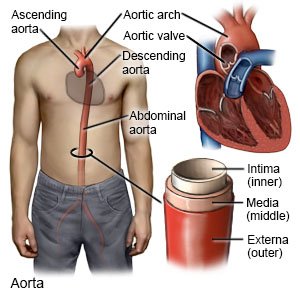Aortic Disease
Medically reviewed by Drugs.com. Last updated on Sep 23, 2025.
Aortic disease is a general term to describe conditions that affect the aorta or the aortic valve. The aorta is a large blood vessel that goes from your heart down into your abdomen. The valve opens to let blood go from your heart into your aorta. The valve then closes to prevent blood from flowing back into your heart. An aortic disease develops because the aorta or its valve is weakened, damaged, or not formed correctly. The main aortic diseases are aneurysms and dissections. An aneurysm is a bulge that may rupture (burst). A dissection is a tear that happens suddenly. A rupture or tear is a life-threatening emergency.
 |
WHILE YOU ARE HERE:
Informed consent
is a legal document that explains the tests, treatments, or procedures that you may need. Informed consent means you understand what will be done and can make decisions about what you want. You give your permission when you sign the consent form. You can have someone sign this form for you if you are not able to sign it. You have the right to understand your medical care in words you know. Before you sign the consent form, understand the risks and benefits of what will be done. Make sure all your questions are answered.
Medicines:
- Blood pressure (BP) medicine may be needed to lower your BP to prevent a tear or rupture.
- Cholesterol medicine may be needed to lower your cholesterol level and prevent atherosclerosis. This can help prevent a heart attack or stroke.
- Antiplatelet medicine, such as aspirin, may be used to help prevent a clot. A clot could travel to your heart or brain and cause a heart attack or stroke.
Tests:
- Blood tests may show if enough oxygen is getting to organs such as your kidneys and how well the organs are working. You may also need blood tests to check how well your blood is clotting.
- A CT, PET scan, MRI, or ultrasound may show a bulge, tear, or other problem in your aorta. You may be given contrast liquid to help your aorta show up better in pictures. Tell the healthcare provider if you have ever had an allergic reaction to contrast liquid. Do not enter the MRI room with anything metal. Metal can cause serious injury. Tell the provider if you have any metal in or on your body.
- An echocardiogram may show problems with your aorta and how blood flows through your heart. It may also show how well your heart is pumping.
Treatment:
- Endovascular repair is a procedure that uses a graft to repair your aorta. A graft is a wire mesh tube. You may need more than 1 endovascular repair.
- Surgery may be needed to repair your aorta or remove a clot or blockage in your aorta. You may instead need surgery to replace part of your aorta. Your aortic valve may need to be replaced if it is not opening or closing well.
RISKS:
Your aortic disease may get worse even with treatment. Your aorta may dissect or rupture and cause damage to your other organs. You may need 1 or more procedures to repair your aorta. You may have an increased risk for a heart attack or stroke. Pregnancy may make your aortic disease worse. Your aorta may rupture or dissect during your pregnancy. This could be life-threatening for you and your baby.
CARE AGREEMENT:
You have the right to help plan your care. Learn about your health condition and how it may be treated. Discuss treatment options with your healthcare providers to decide what care you want to receive. You always have the right to refuse treatment.© Copyright Merative 2025 Information is for End User's use only and may not be sold, redistributed or otherwise used for commercial purposes.
The above information is an educational aid only. It is not intended as medical advice for individual conditions or treatments. Talk to your doctor, nurse or pharmacist before following any medical regimen to see if it is safe and effective for you.
Further information
Always consult your healthcare provider to ensure the information displayed on this page applies to your personal circumstances.
